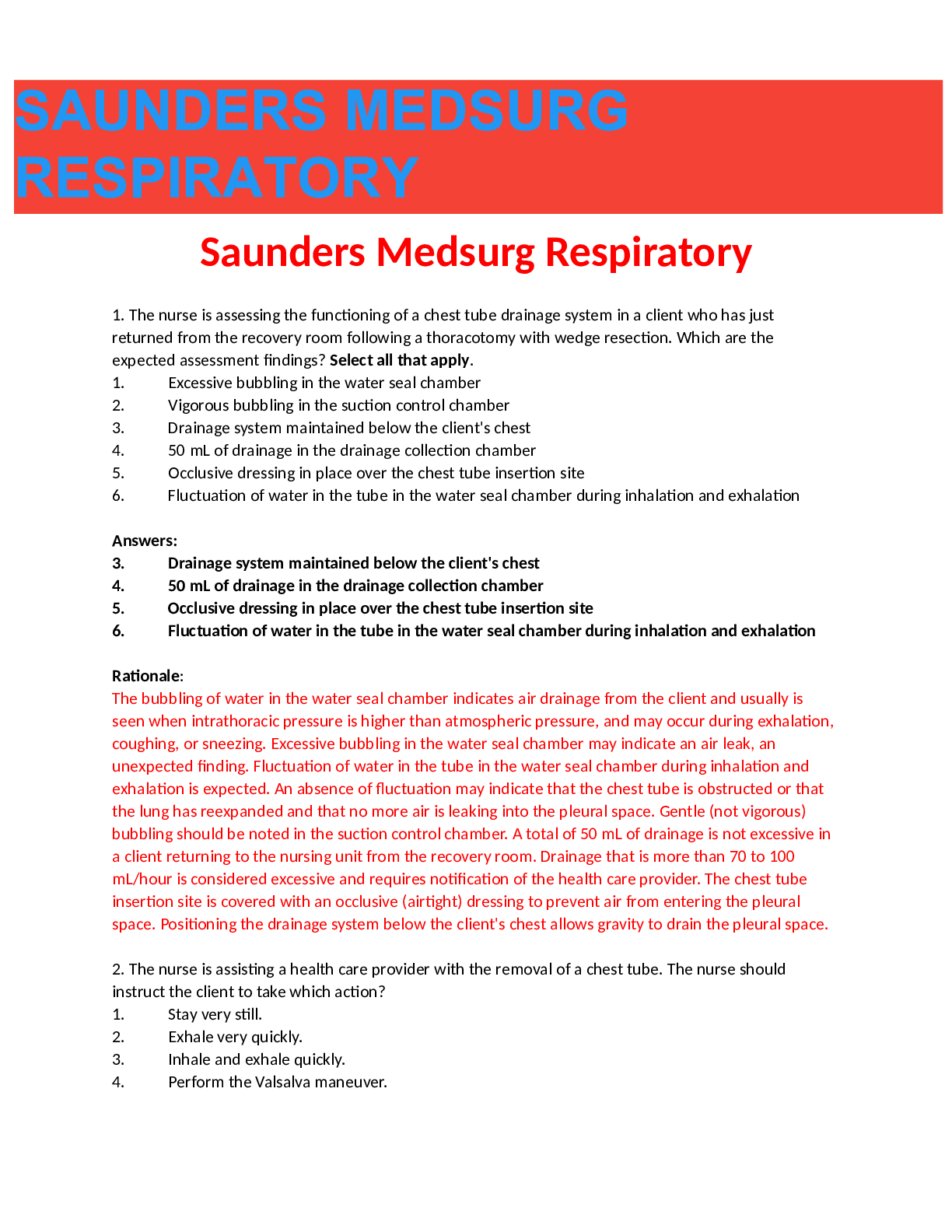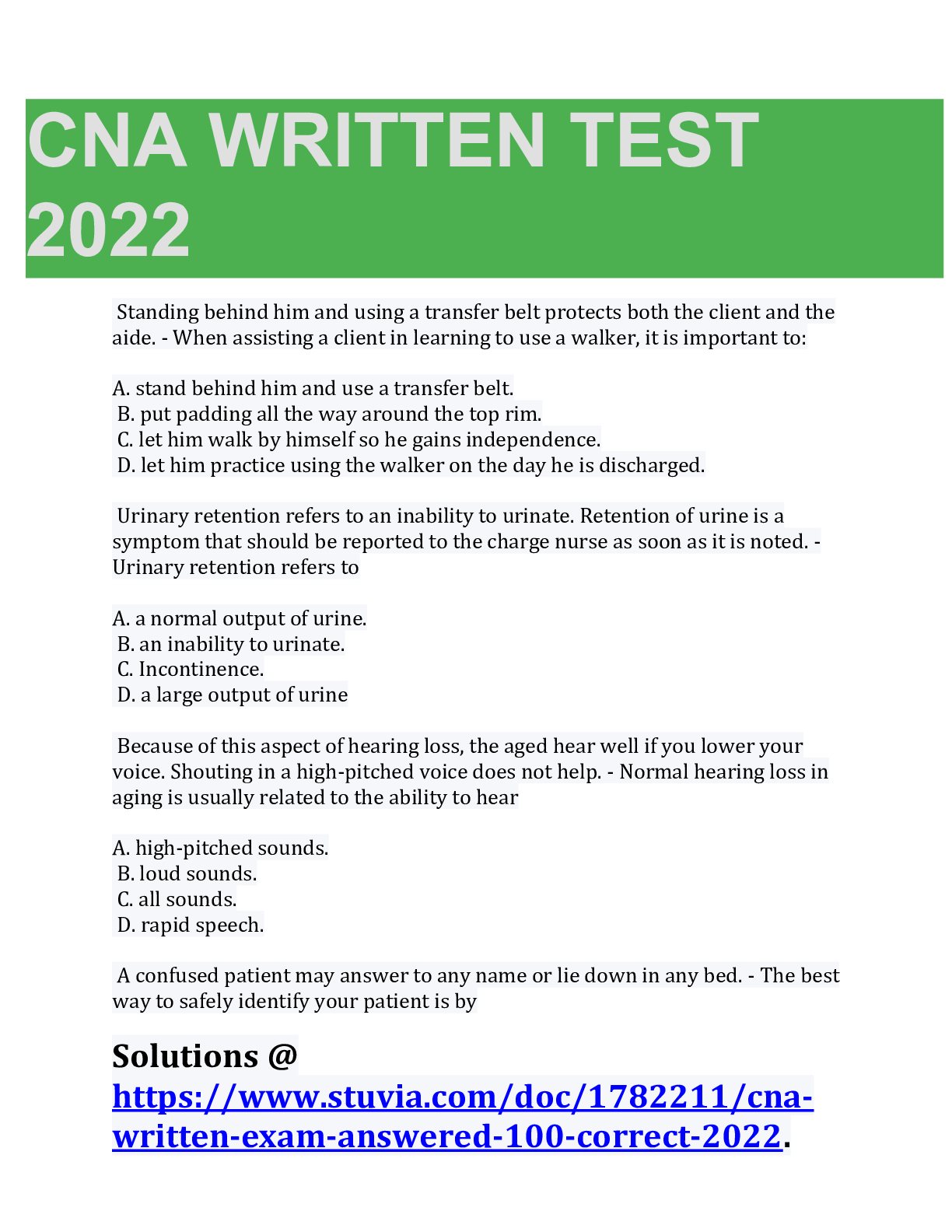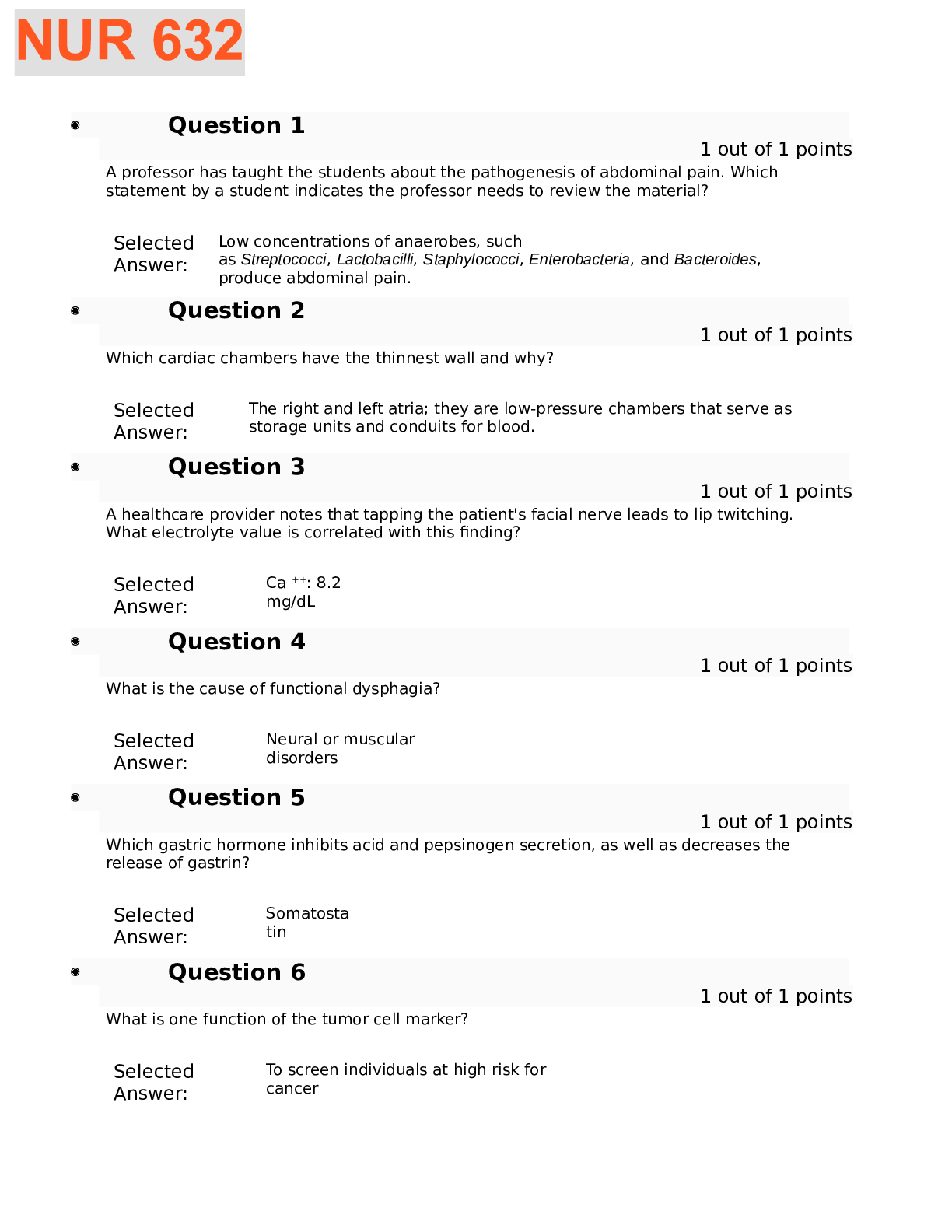*NURSING > QUESTIONS & ANSWERS > Saunders Medsurg Respiratory Revised 20 August 2019 (All)
Saunders Medsurg Respiratory Revised 20 August 2019
Document Content and Description Below
Saunders Medsurg Respiratory Revised 20 August 20191. The nurse is assessing the functioning of a chest tube drainage system in a client who has just returned from the recovery room following a thora... cotomy with wedge resection. Which are the expected assessment findings? Select all that apply. 1. Excessive bubbling in the water seal chamber 2. Vigorous bubbling in the suction control chamber 3. Drainage system maintained below the client's chest 4. 50 mL of drainage in the drainage collection chamber 5. Occlusive dressing in place over the chest tube insertion site 6. Fluctuation of water in the tube in the water seal chamber during inhalation and exhalation Answers: 3. Drainage system maintained below the client's chest 4. 50 mL of drainage in the drainage collection chamber 5. Occlusive dressing in place over the chest tube insertion site 6. Fluctuation of water in the tube in the water seal chamber during inhalation and exhalation Rationale: The bubbling of water in the water seal chamber indicates air drainage from the client and usually is seen when intrathoracic pressure is higher than atmospheric pressure, and may occur during exhalation, coughing, or sneezing. Excessive bubbling in the water seal chamber may indicate an air leak, an unexpected finding. Fluctuation of water in the tube in the water seal chamber during inhalation and exhalation is expected. An absence of fluctuation may indicate that the chest tube is obstructed or that the lung has reexpanded and that no more air is leaking into the pleural space. Gentle (not vigorous) bubbling should be noted in the suction control chamber. A total of 50 mL of drainage is not excessive in a client returning to the nursing unit from the recovery room. Drainage that is more than 70 to 100 mL/hour is considered excessive and requires notification of the health care provider. The chest tube insertion site is covered with an occlusive (airtight) dressing to prevent air from entering the pleural space. Positioning the drainage system below the client's chest allows gravity to drain the pleural space. 2. The nurse is assisting a health care provider with the removal of a chest tube. The nurse should instruct the client to take which action? 1. Stay very still. 2. Exhale very quickly. 3. Inhale and exhale quickly. 4. Perform the Valsalva maneuver. Answers: 4. Perform the Valsalva maneuver. Rationale: When the chest tube is removed, the client is asked to perform the Valsalva maneuver (take a deep breath, exhale, and bear down). The tube is quickly withdrawn, and an airtight dressing is taped in place. An alternative instruction is to ask the client to take a deep breath and hold the breath while the tube is removed. 3. The nurse caring for a client with a pneumothorax and who has had a chest tube inserted notes continuous gentle bubbling in the water seal chamber. What action is most appropriate? 1. Do nothing, because this is an expected finding. 2. Check for an air leak, because the bubbling should be intermittent. 3. Increase the suction pressure so that the bubbling becomes vigorous. 4. Clamp the chest tube and notify the health care provider immediately. Answer: 2. Check for an air leak, because the bubbling should be intermittent. Rationale: Fluctuation with inspiration and expiration, not continuous bubbling, should be noted in the water seal chamber. Intermittent bubbling may be noted if the client has a known pneumothorax, but this should decrease as time goes on and as the pneumothorax begins to resolve. Therefore, the nurse should check for an air leak. If a wet chest drainage system is used, bubbling would be continuous in the suction control chamber and not intermittent. In a dry system, there is no bubbling. Increasing the suction pressure only increases the rate of evaporation of water in the drainage system; in addition, increasing the suction can be harmful and is not done without a specific prescription to do so if using a wet system. Dry systems will allow for only a certain amount of suction to be applied; an orange bellow will appear in the suction window, indicating that the proper amount of suction has been applied. Chest tubes should be clamped only with a health care provider's prescription. 5. The emergency department nurse is assessing a client who has sustained a blunt injury to the chest wall. Which finding indicates the presence of a pneumothorax in this client? 1. A low respiratory rate 2. Diminished breath sounds 3. The presence of a barrel chest 4. A sucking sound at the site of injury Answer: 2. Diminished breath sounds Rationale: This client has sustained a blunt or closed-chest injury. Basic symptoms of a closed pneumothorax are shortness of breath and chest pain. A larger pneumothorax may cause tachypnea, cyanosis, diminished breath sounds, and subcutaneous emphysema. Hyperresonance also may occur on the affected side. A sucking sound at the site of injury would be noted with an open chest injury. 6. The nurse is caring for a client hospitalized with acute exacerbation of chronic obstructive pulmonary disease. Which findings would the nurse expect to note on assessment of this client? Select all that apply. 1. A low arterial PCo2 level 2. A hyperinflated chest noted on the chest x-ray 3. Decreased oxygen saturation with mild exercise 4. A widened diaphragm noted on the chest x-ray 5. Pulmonary function tests that demonstrate increased vital capacity Answers: 2. A hyperinflated chest noted on the chest x-ray 3. Decreased oxygen saturation with mild exercise Rationale: Clinical manifestations of chronic obstructive pulmonary disease (COPD) include hypoxemia, hypercapnia, dyspnea on exertion and at rest, oxygen desaturation with exercise, and the use of accessory muscles of respiration. Chest x-rays reveal a hyperinflated chest and a flattened diaphragm if the disease is advanced. Pulmonary function tests will demonstrate decreased vital capacity. 7. The nurse instructs a client to use the pursed-lip method of breathing and evaluates the teaching by asking the client about the purpose of this type of breathing. The nurse determines that the client understands if the client states that the primary purpose of pursed-lip breathing is to promote which outcome? 1. Promote oxygen intake. 2. Strengthen the diaphragm. 3. Strengthen the intercostal muscles. 4. Promote carbon dioxide elimination. Answer: 4. Promote carbon dioxide elimination. Rationale: Pursed-lip breathing facilitates maximal expiration for clients with obstructive lung disease. This type of breathing allows better expiration by increasing airway pressure that keeps air passages open during exhalation. Options 1, 2, and 3 are not the purposes of this type of breathing. 9. The nurse is caring for a client after a bronchoscopy and biopsy. Which finding, if noted in the client, should be reported immediately to the health care provider? 1. Dry cough 2. Hematuria 3. Bronchospasm 4. Blood-streaked sputum [Show More]
Last updated: 2 years ago
Preview 1 out of 37 pages

Buy this document to get the full access instantly
Instant Download Access after purchase
Buy NowInstant download
We Accept:

Reviews( 0 )
$13.00
Can't find what you want? Try our AI powered Search
Document information
Connected school, study & course
About the document
Uploaded On
Oct 03, 2022
Number of pages
37
Written in
Additional information
This document has been written for:
Uploaded
Oct 03, 2022
Downloads
0
Views
34








.png)


